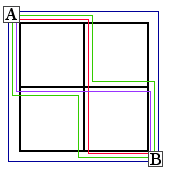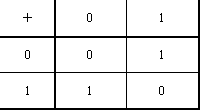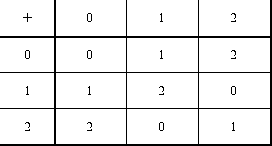Teaching Notes for the Patterns in Pascal’s Triangle Problem
Students with a wide range of mathematics backgrounds can work
productively on this project. The introductory activities and
expectations for student discoveries should differ depending on
whether or not students have the useful prerequisites for this project. Depending on
the students’ level, you may choose to begin with some of the
warm-up problems or use the warm-ups at relevant points during the
research (answers to the warm-up problems are available in the results section).
Introducing the Project
For students unfamiliar with Pascal’s triangle, or with any of the settings
in which it is encountered, there should be an initial period
of exploration with the triangle itself (before launching into
its “mod” versions). If time is constrained and you
want students to focus on the arithmetic and modular aspects of
the problem, introduce them to the triangle by presenting a few
rows and the addition rule for generating further rows.
If you are hoping that students will be able to make connections
between the different ways of thinking about the entries of Pascal’s
triangle, you can have them discover it themselves. Some of the
most familiar sources of Pascal’s triangle are given in warm
up problem #5. For an algebraic approach to discovering the
triangle, ask the students to find, organize, and describe the coefficients
of  for
n = 0, 1, 2, etc. This exploration can lead to a discovery
of the binomial theorem (warm up
problem #6).
for
n = 0, 1, 2, etc. This exploration can lead to a discovery
of the binomial theorem (warm up
problem #6).
A combinatorial approach that you can use with students, with
or without an algebra background, is to count the number of different
paths that travel from one corner to the opposite corner of an
m by n grid in the shortest distance possible
(e.g., always heading south or east). The figure below shows the
six paths from corner A to corner B of a 2 by
2 grid. Note that a 0 by n “grid” has exactly
one possible path. In general, you are moving n + m
steps, of which n are in one direction and m
are in the perpendicular direction. Therefore, there are  (or
(or  ) different ways
to choose when to take those n (or m) steps
in a particular direction.
) different ways
to choose when to take those n (or m) steps
in a particular direction.

The six paths through a 2 by 2
grid
Another combinatorial problem that generates the triangle is
to find the number of distinct n-digit sequences that
can be made with k 0’s and n – k
1’s (or vice versa). This setting is particularly powerful
because it is a relatively straightforward challenge to turn many
different counting problems into a problem involving such sequences.
For example, the paths above are just rearrangements of two 0’s
and two 1’s with an 0 representing a move south and a 1 representing
a move east. For the subset definition in warm up problem #5, the ith digit in an n–digit
sequence could indicate whether (1) or not (0) to include the
ith element in a set. Showing the equivalence between
any two of the settings that generate Pascal’s triangle makes
for a good student experience thinking about isomorphisms and
explaining connections (download Binomial Handout for another practice activity).
Once students have, either through discovery or presentation, a
few rows of the triangle and a means for generating it, ask them to
each extend the table by hand for several more rows. There are many
patterns in the triangle that students can spend time exploring.
They are sure to notice the symmetry of the triangle as well as
some of the patterns within the diagonals (those values the same
distance from the left, or right, of each row) such as the counting
sequence or the triangular numbers (1, 3, 6, 10, 15, …). Some
might even notice that the sum of the numbers in each row is a
power of 2 (can they explain why?).
Once students have a feel for the triangle itself, introduce
some of the main questions (either question 1 alone, 1 with 2, or 1
with 3 would make good starting points).
Working on the Project
Because the values in Pascal’s triangle grow so quickly, an
early challenge that students face is the development of an
efficient way to extend the rows while keeping track of just the parity of the entries.
Once they realize that calculating the numbers becomes unwieldy,
encourage them to think of a way to avoid having to make those
calculations. Is it possible to keep track of just evenness or
oddness (or, in preparation for other moduli, of the remainders
after division by 2)? You might suggest that they create an
addition table for the possible remainder combinations:

Addition of numbers mod 2
Ask the students to try to prove their arithmetic facts (e.g.,
that an odd plus an odd is even). If students use the labels “odd”
and “even” rather than the remainders, encourage them
to use the whole word and not the intitials to avoid later confusion
between “O” for “odd” and the remainder 0.
As students move into other divisors, they will probably move from words that
describe the remainders (such as “even”) to using the
value for the remainder itself. You may choose to introduce the
notation and ideas of modular arithmetic
at this point or allow them to develop their own descriptions.

Addition of numbers mod 3
If students propose a table such as the one above,
can they prove that their patterns will always hold? For example,
if examples suggest that the sum of a number congruent to 2 (mod
3) and one congruent to 1 (mod 3) is always 0 (mod 3), can they
prove the general case? One tool they can be shown is the algebraic
form for classes of numbers with the same remainder: numbers that
leave a remainder, r, after division by d can
be represented by dm + r, m an integer
(e.g., numbers that leave a remainder of 2 when divided by 3 are
of the form 3m +2: 17 = 3.5 + 2). So the above
sum can be represented as (3m + 2) + (3n + 1)
= 3m + 3n + 3 = 3(m + n +
1) which is clearly divisible by 3 (and therefore congruent to
0 mod 3).
Once students are ready to begin work on the coloring problems
(project problems number 3 or 4),
distribute several copies of the Pascal’s triangle coloring sheets
for them to use. You might leave questions about alternatives to
generating the values in Pascal (rather than the remainders) until
this activity, since the coloring may lead some students to think
about rules for "adding" colors (red + red = blue, blue + blue =
blue, blue + red = red). Once they do so, you can guide them to
make a connection to the numerical rules.
It is important to note, at some point, that our interest is not really in
the 100th row per se, but in a pattern that we can extend and generalize.
“100” is an arbitrary placeholder for “large number
that you would not want to work out by hand.” We can use a
computer to answer questions such as “how many numbers of a
given type show up in row n?” But, the interesting
challenge is to find rules that allow us to answer such questions
readily for any n, to be able to prove that our rules really
work, and to be able to make connections between the formulas that
we discover and the different ways that Pascal is generated. That
said, technology can be a welcome aid in generating data (especially
when we want to look at large portions of the triangle for varying
divisors).
Students may struggle to express the patterns that they identify.
For example, the number of odds by rows follows a complex pattern
that is not easy to explain: 1, 2, 2, 4, 2, 4, 4, 8, 2, 4, 4,
8, 4, 8, 8, 16, 2, 4, 4, 8, …. Students may note that all
numbers are powers of two and that each group of four terms is
of the form 2n, 2n+1, 2n+1, 2n+2,
but still find that predicting the next group is not so easy.
With enough data, they may notice the way the pattern repeats
and extends recursively (see results). Encourage them to express the patterns at first
in whatever way they can. Many will be most comfortable with an
English sentence or two. Topics which might then be of help (depending
on the students’ observations) include binary representations
and recursively-defined functions.
Students’ conjectures and questions will head in a number
of possible directions. It is appropriate to use those questions as
an opportunity to introduce students to topics that might be of
help (e.g., number theory
ideas, proof by
induction).
Thinking in terms of prime and composite numbers
is central to understanding the different patterns that arise when
coloring the triangle remainders for different divisors. Extension
problem #3, which can be proven using the binomial theorem, provides
a general purpose tool for analyzing Pascal’s triangle mod
a prime number p. The theorem,  ,
tells us that the pth row will have zeroes in all but the
first and last positions because the coefficients of all of the
terms in between in the expansion of
,
tells us that the pth row will have zeroes in all but the
first and last positions because the coefficients of all of the
terms in between in the expansion of  are congruent to 0 mod p. To understand this claim, look
at the right-hand side of the congruence. None of the
are congruent to 0 mod p. To understand this claim, look
at the right-hand side of the congruence. None of the  terms are present, so their coefficients must be a multiple of p.
This congruence can be applied to study the presence of zeroes in
other lines. For example, to see what the pattern will be in lines
that are a multiple of p, we raise both sides to the kth
power:
terms are present, so their coefficients must be a multiple of p.
This congruence can be applied to study the presence of zeroes in
other lines. For example, to see what the pattern will be in lines
that are a multiple of p, we raise both sides to the kth
power:
 and, after expanding,
and, after expanding,

This expansion shows that only every pth entry in row
kp will be non-zero.
Using Technology
The resources provide links
and pre-made spreadsheets that students can use in their
explorations. It is not difficult, however, for students to create
their own spreadsheets for exploring Pascal’s triangle.
There are two reasonable approaches to creating a Pascal’s
triangle spreadsheet. The easiest route is to make a column and row
of 1’s and then fill in all of the other cells with the
formula that adds the cell to the left and the cell above (see
figure below). These 1’s and formulas do not have to be typed
individually. Just type in the contents of cells A1 and B2 and
click and drag the contents into the other cells (or use the fill
down and fill right commands).
| |
A
|
B
|
C
|
|
1
|
1
|
1
|
1
|
|
2
|
1
|
= A2 + B1
|
= B2 + C1
|
|
3
|
1
|
= A3 + B2
|
= B3 + C2
|
A spreadsheet that generates
Pascal’s triangle (rotated 45°)
This spreadsheet design leaves the rows of Pascal’s
triangle in the diagonals of the spreadsheet. If students are going
to print out and color the sheet, that arrangement poses no
difficulty. However, it is also possible to use a spreadsheet to
calculate the totals of the entries or the number of odds in a row
(using the Sum function). To take advantage of that automated data
collection, the triangle needs to have its rows aligned with rows
of the spreadsheet. The figures below show how to structure this
arrangement. We start the triangle in column C to leave room for
summary formulas.
| |
A
|
B
|
C
|
D
|
E
|
|
1
|
= Sum(C1:BZ1)
|
|
1
|
0
|
0
|
|
2
|
= Sum(C2:BZ2)
|
|
1
|
= C1 + D1
|
= D1 + E1
|
|
3
|
= Sum(C3:BZ3)
|
|
1
|
= C2 + D2
|
= C2 + D2
|
A spreadsheet that generates Pascal’s
triangle (skewed)
| |
A
|
B
|
C
|
D
|
E
|
|
1
|
1
|
|
1
|
0
|
0
|
|
2
|
2
|
|
1
|
1
|
0
|
|
3
|
4
|
|
1
|
2
|
1
|
The output from the above
spreadsheet
Students can manually color the cells of the spreadsheet using
the paint bucket tool.
Whether students are using a spreadsheet, a program of their own
design, or a calculator, the triangle values will ultimately reach
a point where the tool is rounding the results of the computations
(unless the students use a computer algebra system such as Mathematica®).
At this point, the numbers are no longer suitable for determining
the remainders. One way to circumvent this limitation is to use
the addition rule for generating the triangle and only work with
the remainders (e.g., use “= MOD(C1+D1,2)” which adds
the two elements above and immediately finds the remainder). This
approach would need justification using ideas, such as those discussed
above, that show that the remainder
of the sum of two numbers can be found from the sum of the remainders
of those numbers. Students working with “even” and “odd”
might use a formula such as “= If(A1=A2, “E”, “O”)”,
but this type of rule becomes cumbersome beyond mod 2.
A good challenge for students who know how to program is to write
a program that produces  mod m even for very large values that the
computer cannot handle directly (they can think in terms of the
process of calculating
mod m even for very large values that the
computer cannot handle directly (they can think in terms of the
process of calculating  and avoid overly large intermediate values).
and avoid overly large intermediate values).
Closure
All groups should have an answer to the first project question.
Their answer should be supported by general reasoning (and not just
by number crunching up to the hundredth row). Students may justify
their claim using descriptions of, and observing connections
between, the numerical and geometric patterns. Students without
knowledge of number theory or algebra will have greatest success
justifying claims about the geometric patterns. Students should
also be able to explain the arithmetic of remainders in a
convincing fashion. A younger student may use words or pictures to
show why an odd plus an even must be odd, while an older student
might do so symbolically.
Each student or group should strive to have a list of main
observations, conjectures, numerical results, and, when possible,
proofs.